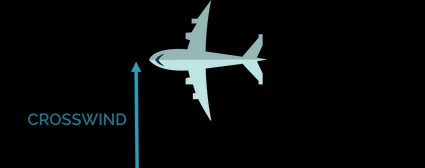Crosswind Calculator
The crosswind calculator can help you find the crosswind, headwind, and tailwind components of the blowing wind. Whether you are a pilot, van driver, or race cyclist, you need to take crosswinds into account to travel safely. Read the text to learn what is and how to calculate the crosswind component. We will also explain how to use a crosswind component chart.
If you fly often, you might want to look at flight radiation calculator to estimate the cosmic-radiation exposure you get during your airplane flight.
Wind components: crosswind, headwind, and tailwind
Wind affects the motion of vehicles and aircraft. Pilots have to consider the effect of wind, especially while landing or taking off. There are three wind components:
- Crosswind — wind component that blows from the side of the airplane;

- Headwind — wind component that blows in the opposite direction to the aircraft motion; and

- Tailwind — wind component that blows in the same direction as the aircraft motion.

The wind rarely blows pure crosswind or head/tailwind. Mostly it blows at a certain angle and can be separated into two portions — components. Some navigation instruments provide pilots with the wind components' values. If you don't have access to those, it's good to know how to calculate them quickly.
How do you calculate crosswind component?
To find the crosswind component, you need to multiply wind speed by the sine of the angle between wind direction and the direction you're facing:
crosswind speed = wind speed × sin(α)
In this text, α is the angle of the wind from the direction of travel. This angle should be between -90 and 90 degrees.

How do you calculate headwind and tailwind component?
To find the headwind or tailwind component, multiply wind speed by the cosine of the angle between wind direction and the direction you're facing:
head(or tail)wind speed = wind speed × cos(α)
If the wind blows from the front, it's a headwind, and if from the back, it's a tailwind. The direction doesn't affect the equation.

🙋 Interested in the math behind this equation? Go to the vector projection calculator to learn more.
How to use our crosswind calculator
- First, pick the runway number. It can have a value between 1 and 36.
💡 The runway number represents the magnetic, cardinal directions: 36 – North, 27 – West, 18 – South, and 9 – East; and can be found painted on runways. It represents a plane's magnetic direction of travel.
-
Second, type in the magnetic direction from which the wind is blowing.
-
Finally, input the wind speed.
-
The crosswind calculator will tell you the speeds of all acting wind components.
Before you go, learn about the effect of wind on an aircraft flight path in the wind correction angle calculator.
How to use crosswind component chart?
To use a crosswind component chart follow these few steps:
-
Find the line with the value of an angle between the wind direction and the direction you're facing (it should be between 0 and 90 degrees).
-
Follow that line until you reach the correct wind speed (the arches describe the wind speed).
-
From this point go straight down to find the crosswind component, and straight to the left to find the headwind component.
What are tailwind and headwind?
Tailwind and headwind are wind components. Tailwind is the wind that blows in the direction of travel. Headwind blows in the opposite direction. There is also another wind component called crosswind. It blows from the side of an object.